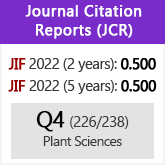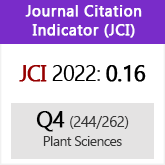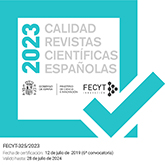Genome size, chromosome number, and rDNA organisation in Algerian populations of Artemisia herba-alba (Asteraceae), a basic plant for animal feeding facing overgrazing erosion
DOI:
https://doi.org/10.3989/ajbm.2415Keywords:
Anthemideae, Artemisia herba-alba, chromosome number, cytogenetics, fluorescent in situ hybridisation, genome organisation, genome size, karyology, polyploidy, rDNA lociAbstract
Artemisia herba-alba is a largely-distributed and often landscape-dominating taxon in arid areas of the Mediterranean and Irano-Turanian regions. In Algeria, in 2010 its communities covered 10% of the steppe territory, but its populations have been subjected to overgrazing. A karyological study based on 22 populations together with a cytogenetic characterisation of this species has been performed for the first time in Algerian materials, through genome size and chromosome number determination. Fluorescence in situ hybridisation (FISH) was also used to assess the rDNA loci number and distribution in the two ploidy levels detected. The studied accessions are diploid (2n = 2x = 18 chromosomes, 6 populations) or tetraploid (2n = 4x = 36 chromosomes, 15 populations). One population, occupying a more or less central geographic position among the studied area, presented both cytotypes. Genome size reflects well the two ploidy levels, with no evidence of downsizing with polyploidy. The karyotypes are rather symmetric (2A Stebbins’ class). FISH analyses detected four signals (2 loci) in diploid and eight signals (4 loci) in tetraploid cytotypes for both ribosomal DNA genes, which present an L-type (linked) organisation, i.e. with loci from both rDNA genes colocalised. The presence of two ploidy levels suggest a genomic dynamism and even a possible differentiation underlying the morphological uniformity and despite the dramatic decrease experienced by this plant in Algeria in terms of surface coverage.
Downloads
References
Aidoud, A. 1988. Les écosystèmes steppiques à armoise blanche (Artemisia herba-alba Asso): Caractères généraux. Biocénose: Bulletin d'écologie terrestre 3(12).
Bennett, M.D. & Leitch, I.J. 2005. Nuclear DNA amounts in angiosperms: progress, problems, prospects. Annals of Botany 95: 45-90. https://doi.org/10.1093/aob/mci003 PMid:15596457 PMCid:PMC4246708
Betina, S., Khalfallah, N. & Khelifi, D. 2007. Étude cytogénétique et biochimique de huit populations d'armoise blanche algérienne Artemisia herba-alba Asso. Revue des Régions Arides 2007(2): 602-607.
Bougoutaia, Y., Nedjimi, B., Adda, A. & Kaid-Harche, M. 2014. Étude caryologique et moléculaire de deux populations algériennes d'Artemisia herba alba Asso. (Asteraceae). Revue Agriculture 8: 21-25.
Brochmann, C. & Brysting, A. 2004. Polyploidy in arctic plants. Biological Journal of the Linnean Society 82: 521-536. https://doi.org/10.1111/j.1095-8312.2004.00337.x
Cui, L., Wall, P.K., Leebens-Mack, J.H., Lindsay, B.G., Soltis, D.E., Doyle, J.J., Soltis, P.S., Carlson, J.E., Arumuganathan, K., Barakat, A., Albert, V.A., Ma, H. & DePamphilis, C.W. 2006. Widespread genome duplications throughout the history of flowering plants. Genome Research 16: 738-749. https://doi.org/10.1101/gr.4825606 PMid:16702410 PMCid:PMC1479859
Dolezel, J. 1991. Flow cytometric analysis of nuclear DNA content in higher plants. Phytochemical Analysis 2: 143-154. https://doi.org/10.1002/pca.2800020402
Dolezel, J., Barto?, J., Voglmayr, H. & Greilhuber, J. 2003. Nuclear DNA content and genome size of trout and human. Cytometry 51: 127-128. PMid:12541287
Dolezel, J., Binarová, P. & Lucretti S. 1989. Analysis of nuclear DNA content in plant cells by flow cytometry. Biologia Plantarum 31: 113-120. https://doi.org/10.1007/BF02907241
Duchoslav, M., ?afá?ová, L. & Jandová, M. 2013. Role of adaptive and non-adaptive mechanisms forming complex paterns of genome size variation in six cytotypes of polyploid Allium oleraceum (Amaryllidaceae) on a continental scale. Annals of Botany 111: 419-431. https://doi.org/10.1093/aob/mcs297 PMid:23348752 PMCid:PMC3579448
Fawcett, J., Van de Peer, Y. & Maere, S. 2013 Significance and biological consequences of polyploidization in land plant evolution. In: Leitch, I., Greilhuber J., Dole?el, J. & Wendel, J. (eds.), Plant Genome Diversity 2: 277-293. Springer, Vienna. https://doi.org/10.1007/978-3-7091-1160-4_17
Ferchichi, A. 1997. Contribution à l'étude cytotaxonomique et biologique d'Artemisia herba-alba Asso en Tunisie présaharienne. Acta Botanica Gallica 144: 145-154. https://doi.org/10.1080/12538078.1997.10515761
Garbari, F., Bedini, G. & Peruzzi, L. 2012. Chromosome numbers of the Italian flora. From the Caryologia foundation to present. Caryologia 65: 62-71. https://doi.org/10.1080/00087114.2012.678090
Garcia, S., Canela, M.Á., Garnatje, T., McArthur, E.D., Pellicer, J., Sanderson, S.C. & Vallès, J. 2008. Evolutionary and ecological implications of genome size in the North American endemic sagebrushes and allies (Artemisia, Asteraceae). Biological Journal of the Linnean Society 94: 631-649. https://doi.org/10.1111/j.1095-8312.2008.01001.x
Garcia, S., Garnatje, T., Hidalgo, O., Siljak-Yakovlev, S. & Vallès, J. 2007. Extensive ribosomal DNA (18S-5.8S-26S and 5S) colocalization in the North American endemic sagebrushes (subgenus Tridentatae, Artemisia, Asteraceae) revealed by FISH. Plant Systematics and Evolution 267: 79-92. https://doi.org/10.1007/s00606-007-0558-6
Garcia, S., Garnatje, T. & Kovarik, A. 2012. Plant rDNA database: ribosomal DNA loci information goes online. Chromosoma 121: 389-394. https://doi.org/10.1007/s00412-012-0368-7 PMid:22527113
Garcia, S., Garnatje, T., Pellicer, J., McArthur, E.D., Siljak-Yakovlev, S. & Vallès, J. 2009a. Ribosomal DNA and genome size changes during polyploid and hybrid formation in the North American endemic sagebrushes (Tridentatae, Artemisia). Genome 52: 1012-1024. https://doi.org/10.1139/G09-077 PMid:19953129
Garcia, S., Lim, K.Y., Chester, M., Garnatje, T., Pellicer, J., Vallès, J., Leitch, A.R. & Kova?ík, K. 2009b. Linkage of 35S and 5S rRNA genes in Artemisia (family Asteraceae): first evidence from angiosperms. Chromosoma 118: 85-97. https://doi.org/10.1007/s00412-008-0179-z PMid:18779974
Gouja, H., Garnatje, T., Hidalgo, O., Neffati, M., Raies, A. & Garcia, S. 2015. Physical mapping of ribosomal DNA and genome size in diploid and polyploid North African Calligonum species (Polygonaceae). Plant Systematics and Evolution 301: 1569-1579. https://doi.org/10.1007/s00606-014-1183-9
Greilhuber, J., Dole?el, J., Lysák, M. & Bennett, M.D. 2005. The origin, evolution, and proposed stabilization of the terms 'genome size' and 'C-value' to describe nuclear DNA contents. Annals of Botany 95: 255- 260. https://doi.org/10.1093/aob/mci019 PMid:15596473 PMCid:PMC4246724
Guerra, M. 2008. Chromosome numbers in plant cytotaxonomy: Concepts and implications. Cytogenetics and Genome Research 120: 339-350. https://doi.org/10.1159/000121083 PMid:18504363
HCDS. 2010. Les potentialités agro-pastorales de la steppe Algérienne. Analyse et interprétation des résultats de l'étude. Rapport d'étude. Haut commissariat au développement de la steppe (HCDS), Djelfa.
Houmani, M., Houmani, Z. & Skoula, M. 2004. Intérêt de Artemisia herba-alba Asso dans l'alimentation du bétail des steppes algériennes. Acta Botanica Gallica 151: 165-172. https://doi.org/10.1080/12538078.2004.10516031
Kawatani, T. & Ohno, T. 1964. Chromosome numbers in Artemisia. Bulletin of the National Institute for Hygienic Sciences 82: 183-193.
Kreitschitz, A. & Vallès, J. 2003. New or rare data on chromosome numbers in several taxa of the genus Artemisia (Asteraceae) in Poland. Folia Geobotanica 38: 333-343. https://doi.org/10.1007/BF02803203
Leitch, A.R. & Leitch, I.J. 2008. Genomic plasticity and the diversity of polyploid plants. Science 320: 481-483. https://doi.org/10.1126/science.1153585 PMid:18436776
Leitch, I.J. & Bennett, M.D. 2004. Genome downsizing in polyploid plants. Biological Journal of the Linnean Society 82: 651-663. https://doi.org/10.1111/j.1095-8312.2004.00349.x
Levan, A., Fredga, K. & Sandberg, A.A. 1964. Nomenclature for centromeric position on chromosomes. Hereditas 52: 201-220. https://doi.org/10.1111/j.1601-5223.1964.tb01953.x
Levin, D.A. 2002. The role of chromosomal changes in plant evolution. Oxford University Press, Oxford.
Lumaret, R., Guillerm, J.L., Delay, J., Loutfi, A.A.L., Izco, J. & Jay, M. 1987. Polyploidy and habitat differentiation in Dactylis glomerata L. from Galicia (Spain). Oecologia 73: 436-446. https://doi.org/10.1007/BF00385262
Marie, D. & Brown, S.C. 1993. A cytometric exercise in plant DNA histograms, with 2C values for 70 species. Biology of the Cell 78: 41-51. https://doi.org/10.1016/0248-4900(93)90113-S
Nedjimi, B. & Guit, B. 2012. Les steppes algériennes: causes de déséquilibre. Algerian Journal of Arid Environments 2: 50-61.
Ouyahya, A. & Viano, J. 1988. Recherches cytogénétiques sur le genre Artemisia L. au Maroc. Boletim da Sociedade Broteriana série 2, 61: 105-124.
Pellicer, J., Garnatje, T., Molero, J., Pustahija, F., Siljak-Yakovlev, S. & Vallès, J. 2010. Origin and evolution of the South American endemic Artemisia species (Asteraceae): evidence from molecular phylogeny, ribosomal DNA and genome size data. Australian Journal of Botany 58: 605-616. https://doi.org/10.1071/BT10047
Podlech, D. 2013. Some remarks on Artemisia subgenus Seriphidium (Asteraceae) mostly from Afghanistan. Rostaniha 14: 48-58.
Pouget M. 1980. Les relations sol-végétation dans les steppes sud-algéroises. ORSTOM (collection "Travaux et Documents"), Paris.
Romero, C. 1986. A new method for estimating karyotype asymmetry. Taxon 35: 526-530. https://doi.org/10.2307/1221906
Siljak-Yakovlev, S., Pustahija, F., Vicic, V. & Robin, O. 2014. Molecular cytogenetics (FISH and fluorochrome banding): resolving species relationships and genome organization. Methods in Molecular Biology 1115: 309-323. https://doi.org/10.1007/978-1-62703-767-9_15 PMid:24415481
Soltis, D.E., Albert, V.A., Leebens-Mack, J., Bell, C.D., Paterson, A.H., Zheng, C., Sankoff, D., Depamphilis, C.W., Wall, P.K. & Soltis, P.S. 2009. Polyploidy and angiosperm diversification. American Journal of Botany 96: 336-348. https://doi.org/10.3732/ajb.0800079 PMid:21628192
Stebbins, G.L. 1971. Chromosomal evolution in higher plants. Edward Arnold, London.
Stuessy, T.F. 2009. Plant taxonomy. The systematic evaluation of comparative data, ed. 2. Columbia University Press, New York. PMCid:PMC4268500
Stuessy, T.F. 2011. Multiple sources of comparative data for creative monography. In: Stuessy, T.F. & Lack, H.W. (eds.), Monographic plant systematics. Fundamental assessment of plant biodiversity: 33-47. Ruggell ARG Ganeter Verlag KG.
Torrell, M., Cerbah, M., Siljak-Yakovlev, S. & Vallès, J. 2001. Étude cytogénétique de trois taxons du complexe d'Artemisia campestris L. (Asteraceae, Anthemideae): localisation de l'hétérochromatine et de l'ADN ribosomique. Bocconea 13: 623-628.
Torrell, M., Cerbah, M., Siljak-Yakovlev, S. & Vallès J. 2003. Molecular cytogenetics of the genus Artemisia (Asteraceae, Anthemideae): fluorochrome banding and fluorescent in situ hybridization. I. Subgenus Seriphidium and related taxa. Plant Systematics and Evolution 239: 141- 153. https://doi.org/10.1007/s00606-002-0259-0
Torrell, M. & Vallès, J. 2001. Genome size in 21 Artemisia L. species (Asteraceae, Anthemideae): Systematic, evolutionary, and ecological implications. Genome 44: 231-238. http://dx.doi.org/10.1139/ gen-44-2-231
Vallès, J. 1987. Contribución al estudio de las razas ibéricas de Artemisia herba-alba Asso. Boletim da Sociedade Broteriana série 2, 60: 5-27.
Vallès, J. & Torrell, M. 1995. Reports (552-558). In: Kamari, G., Felber, F. & Garbari, F. (eds.), Mediterranean chromosome number reports-5. Flora Mediterranea 5: 357-363.
Vallès, J., Garcia, S., Hidalgo, O., Martín, J., Pellicer, J., Sanz, M. & Garnatje, T. 2011. Biology, genome evolution, biotechnological issues, and research including applied perspectives in Artemisia (Asteraceae). Advances in Botanical Research 60: 349-419. https://doi.org/10.1016/B978-0-12-385851-1.00015-9
Watanabe, K. [2015]. Index to Chromosome Numbers in Asteraceae (http:// www.lib.kobe-u.ac.jp/infolib/meta_pub/G0000003asteraceaeresult-en, accessed November 4, 2015)
Published
How to Cite
Issue
Section
License
Copyright (c) 2016 Consejo Superior de Investigaciones Científicas (CSIC)

This work is licensed under a Creative Commons Attribution 4.0 International License.
© CSIC. Manuscripts published in both the printed and online versions of this Journal are the property of Consejo Superior de Investigaciones Científicas, and quoting this source is a requirement for any partial or full reproduction.All contents of this electronic edition, except where otherwise noted, are distributed under a “Creative Commons Attribution 4.0 International” (CC BY 4.0) License. You may read here the basic information and the legal text of the license. The indication of the CC BY 4.0 License must be expressly stated in this way when necessary.
Self-archiving in repositories, personal webpages or similar, of any version other than the published by the Editor, is not allowed.

















